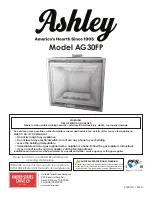
Installation
900004-00, 04/2014
Innovative Hearth Products
Superior™ DRT2000 and DRC2000 Direct-Vent Gas Fireplaces
36
8.
After the wiring is complete, replace the cover plate.
WARNING
Electronic models of these appliances are equipped with a three-prong (grounding)
plug utilized in connecting the electronic components to the junction box in the lower
compartment. This grounding plug provides protection against shock hazard and should be
plugged directly into a properly grounded three-prong receptacle. DO NOT cut or remove the
grounding prong from the plug.
11.
Install the [Optional] Blower Kit after Installation in the Framing
NOTE:
For steps
11
and
12
, it may be helpful to remove the control compartment door (
Page 50
).
FBK-100, FBK-200, and FBK-250 Kits
An electrical outlet box is provided for the installation of the FBK-100, FBK-200, and FBK-250 forced air blower kits.
Electrical power must be provided to the box to operate the blower. Install the blower kit according to the installation
instructions provided with the kit.
NOTE:
The tab connecting the receptacles of the outlet box must be broken in FBK-100 and FBK-200 blower kit
applications (
Figure 33
).
Figure 33: Junction Box Wiring, 120 V, 60 hz, 1 phase
Ground: green Neutral: white 120
V
AC: black
Wall-mounted ON/
OFF blower switch
or variable speed
control switch
*
Junction
box
Tab
broken
Hot side of
receptacle
Neutral side
of receptacle
Green ground screw
Tab
intact
Field wired
Factory wired
Blower
Ground
Plug blower into
this receptacle
Red
Black
Green
White
12.
Connect the Gas Line
All codes require a shutoff valve mounted in the supply line.
Figure 35
illustrates two methods for connecting the
gas supply. The flex-line method is acceptable in the U.S., however, Canadian requirements vary depending on
locality. Installation must be in compliance with local codes.
NOTE:
Ensure the CPI/IPI switch is set to intermittent mode with the pilot in the OFF position. See control
compartment door label for more information.
NOTE:
A sediment trap is recommended in the gas piping within the home to prevent moisture and debris in the line
from damaging the valve.
NOTE:
Secure all joints tightly using appropriate tools and sealing compounds (ensure propane resistant compounds
are used in propane applications). Optional: Seal around the gas line to prevent cold air leakage. Gas line holes and
other openings can be caulked or stuffed with unfaced fiberglass insulation.
















































